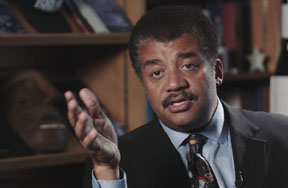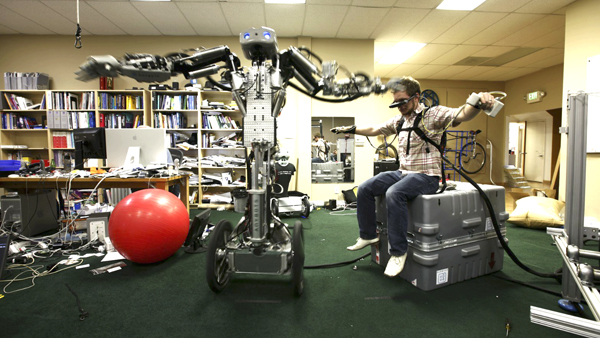The United States first put a man on the moon in 1969, but no American astronaut has set foot there in more than 40 years. The highly informative Fight for Space is one of two films featuring the National Aeronautics and Space Administration and screening at this year’s DOC NYC festival. It starts off by asking the question, “Why did we ever stop?” and uses that as a jumping-off point for exploring the history of manned space exploration. This look back is a study of diminishing returns, but the reasons for how and why prove most fascinating.
Directed by Paul Hildebrandt, the film touches on the origins of NASA’s Apollo program, which did not grow out of lofty humanitarian aspirations but rather from anxiety after the Soviet Union sent the first satellite in orbit around Earth in the late 1950s. Not wanting to cede the literal and figurative high ground, America followed suit, with the more ambitious goal of reaching the moon before the Soviets. As such, NASA’s earliest endeavors were military-driven as opposed to scientific in nature. As one interviewee points out, it wasn’t until 1972’s Apollo 17 mission that scientists were among the crew. (Until then, they were mostly test pilots.)
The film assembles an impressive collection of former astronauts and contemporary experts, such as astrophysicist Neil deGrasse Tyson, to chronicle the decline, which was accelerated by higher-than-estimated costs and a lack of imagination. For example, while the late 1960s brought the Space Shuttle, which was intended to be more cost-effective as it was reusable, NASA had nowhere to send it.
Manned spaceflight was also set back considerably by the Challenger and Columbia disasters of 1986 and 2003, respectively. However, the film and its experts repeatedly cite a lack of political will—in the form of budgets that never met program needs and new initiatives that merely rehashed previous ones—as the main reason for static progress since the Apollo program ended in 1972. (The Space Shuttle program ended in 2011, effectively closing the book on human space exploration through NASA.)
While the earlier parts of Fight for Space are rousing—there is historical footage of President Kennedy’s speech marking the entry into the Space Race, scored to patriotic music—by the second half a sense of disillusionment, even outrage, sets in. Tyson, for his part, takes to task politicians’ claim that we have too many problems on Earth to go into space right now. He makes the counterargument that 1960s America also had its share of issues. Yet as a country, we still made it to the moon.
Ultimately, the film advocates for the rebirth of manned space exploration further into the galaxy, albeit for the sake of scientific inquiry for once, and with private industry taking the lead, motivated by the possibility of enormous profits from new scientific breakthroughs and technologies. More than once, it’s pointed out that research performed during the original Space Race set the groundwork for the Internet, GPS devices, and other important innovations enjoyed today. Although the film is decidedly pro-space, it makes a compelling case that the United States could experience a new era of economic prosperity, if Americans could see beyond themselves and call on elected officials to look to the stars instead.
The University builds on Fight for Space’s idea that profit is more powerful than idealism in shaping technological advancement. Matt Rutherford’s film revolves around Singularity University, where leading minds in engineering and science engage in 10-week programs, bringing their respective disciplines to bear in solving problems facing the world. The end goals are solutions that will positively impact one billion people within the next decade. It’s certainly ambitious, but when the filmmakers ask student participants about potentially changing the world, many of them are modest about their chances.
The group of attendees break into teams: one wants to recycle electronic waste, which the United States develops by tens of millions of tons each year; another seeks to devises a plan to entice car owners to rent out their vehicles to counteract car overpopulation. There’s also Team Made in Space, which believes 3-D printing can make astronauts less dependent on Earth and therefore make space exploration less expensive. It’s worth noting that the school might specialize in scientific endeavors but this is a private institution. Its investors want more than game-changing ideas. They want to make lots of money.
A recurring theme is the importance of success and failure in science—how the former is often accompanied by lots of the latter. But instead of showing its brilliant students navigating the problems related to their projects in the classroom setting, the film switches its focus to school perks: meetings with Hollywood celebrities and a zero-gravity flight that serves as a breather for the students (and which looks like an amazing time). There is a subplot about investors pulling their funding after too many mediocre 10-year projects, but that’s not enough to keep The University from seeming like an infomercial for the school.
The film was made with the full cooperation of NASA. In fact, Singularity University’s campus is located at NASA’s Ames Research in Mountain View, California. School founder Peter Diamandis mentions growing up inspired by the Apollo missions, and his faculty includes former astronaut Dan Barry (who has since left), who tells about spending two decades applying to be an astronaut before getting accepted, defying those who said he was too old. The point seems to be that breakthroughs of any type are worth the wait.
There are moments that genuinely provoke thought: the film touches on the more controversial aspects of technology, such as the possibility of creating weapons through synthetic biology or robots displacing humans at the workplace as they become more advanced and prevalent. Ultimately, many of the students’ projects are shown to have great implications for humanity, including the previously mentioned Team Made in Space, if it helps reignite manned space exploration.
Meanwhile, the aforementioned car-sharing program, reborn as Getaround, has earned millions of dollars in funding to date. Its profitability might explain why our access to its nuts and bolts, like seemingly so much else at Singularity University, is so limited.
Fight for Space will screen on November 14 and 15 and The University on Nov. 17.


















Leave A Comment